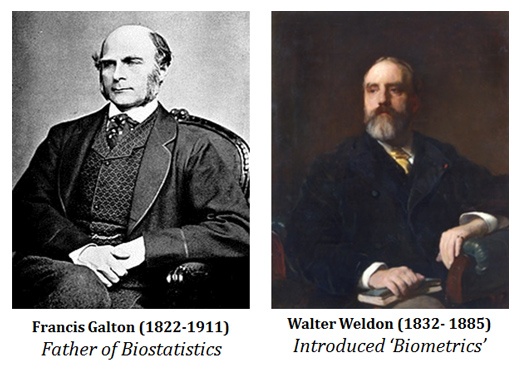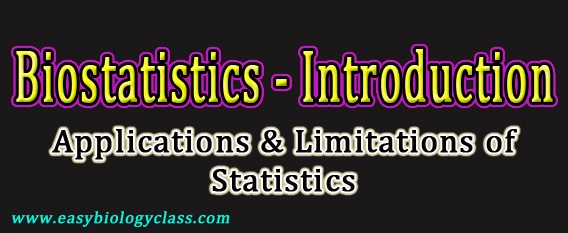What is Statistics?
Statistics is a branch of applied mathematics which deals with the collection, classification, analysis and interpretation of data. The word statistics is derived from the Latin word ‘status’ means a ‘political state’ or ‘government’.
What is Biostatistics?
Biostatistics is a branch of biological science which deals with the study and methods of collection, presentation, analysis and interpretation of data of biological research. Biostatistics is also called as biometrics since it involves many measurements and calculations. In biostatistics, the statistical methods are applied to solve biological problems. Basic understanding of biostatistics is necessary for the study of biology particularly doing research in biological science. The statistics will help the biologist to: (1) understand the nature of variability and (2) helps in deriving general laws from small samples.
| You may also like NOTES in... | ||
|---|---|---|
| BOTANY | BIOCHEMISTRY | MOL. BIOLOGY |
| ZOOLOGY | MICROBIOLOGY | BIOSTATISTICS |
| ECOLOGY | IMMUNOLOGY | BIOTECHNOLOGY |
| GENETICS | EMBRYOLOGY | PHYSIOLOGY |
| EVOLUTION | BIOPHYSICS | BIOINFORMATICS |
Francis Galton is called as the ‘Father of Biostatistics’. He created the statistical concept ‘correlation’. Sir Galton for the first time used statistical tools to study differences among human population. He also invented the use of questionnaires and surveys for collecting data on human communities.
The term ‘Biometry’ was introduced by Walter Weldon.

Statistics is classified into two categories
(1). Pure Statistics
(2). Applied Statistics
(1). Pure Statistics
Pure statistics is the basic statistics. The pure statistics is further classified into FOUR sub-categories.
(a). Descriptive statistics
(b). Analytical statistics
(c). Inductive statistics
(d). Inferential statistics
(a). Descriptive Statistics
Ø These are the statistical tools and analysis which describe and summarize the main features of the data.
Ø Example: Measure of central tendency (mean, median, mode), Measure of dispersion (range, standard deviation, mean deviation) etc.
Ø The descriptive statistics explains the characteristics of the data.
Ø They reduce the complexities of the data into simple and logical summaries.
(b). Analytical Statistics
Ø Analytical statistics deals with all tools in the statistics used to compare different variables.
Ø Analytical statistics helps to establish functional relationship between variables (data).
Ø Example: Correlation and Regression
(c). Inductive statistics
Ø Inductive statistics is the use of statistical tools to generate conclusions on the basis of random observations.
(d). Inferential statistics
Ø Inferential statistics is the application of statistical theories to analyze the research problems.
Ø It Includes very complex calculations, analysis and comparisons.
Ø Example: Index numbers, statistical quality control, vital statistics etc.
Classification of Biostatistics
The biostatistics is conventionally divided into two aspects:
(1). The design of experiments for getting or collecting the data.
(2). The statistical analysis or statistical method.
Steps in biostatistics:
A biostatistical investigation is carried out through the following sequential steps.
(1). Collection of data (variable)
(2). Classification of the collected data
(3). Analysis of data
(4). Interpretation of data
Importance of Statistics in Biological Science
Biostatistics has applications in all the branches of life sciences. Few applications of biostatistics are summarized below.
(1). Research
Ø Research is incomplete without the statistics
Ø Every result (data) in the research need to be statistically validated.
Ø For the design of experiments
Ø Selecting the method of collection of data
| You may also like... | ||
|---|---|---|
| NOTES | QUESTION BANK | COMPETITIVE EXAMS. |
| PPTs | UNIVERSITY EXAMS | DIFFERENCE BETWEEN.. |
| MCQs | PLUS ONE BIOLOGY | NEWS & JOBS |
| MOCK TESTS | PLUS TWO BIOLOGY | PRACTICAL |
Ø Deriving logical conclusions from the data
Ø Deriving single values from a group of variables
(2). Medical and Pharmaceutical Science:
Ø For checking the efficiency of drugs
Ø To find out the possible side effects of drugs
Ø For conduction of drug treatment trials
(3). Genetics:
Ø Study the inheritance patterns of genes
Ø Essential for the study of Mendelian genetics
Ø For the studying the genetic structure of a population
Ø Studying the behavior of genes in a population (Population Genetics)
Ø For the mapping chromosomes
(4). In numerical taxonomy (taxonomy with numbers)
(5). For monitoring the community and public health
(6). Demography (study of human population)
(7). Statistics helps to implement policies by the government
(8). Used in weather forecasting
Limitations of Statistics
(1). Statistical laws are true on average. Single observation is not a statistic.
(2). Statistics cannot be applied to single / individual data.
(3). Statistical methods are best applicable on quantitative data.
(4). Statistical method cannot be applied to highly heterogeneous data.
(5). If sufficient care is not exercised in collecting, analyzing and interpreting the data, the statistical results might be misleading.
(6). Only a person expert in statistics can handle the statistical tools efficiently.
(7). There are too many methods to study a single problem in statistics
(8). Statistics does not depict the entire story or the phenomenon.
(9). Statistical results are not always beyond doubt.
(10). Some errors are possible in the statistical decisions. (Type I and Type II Errors in Statistics)
(11). We do not know whether an error has been committed or not.
<< Back to BIOSTATISTICS Notes
You might also like…
@. Biostatistics Lecture Notes
@. Type I and Type II Errors in Statistics
@. Graphical Representation of Data: Part – 1 | Part – 2 | Part – 3 |


Reference plz
10 q All